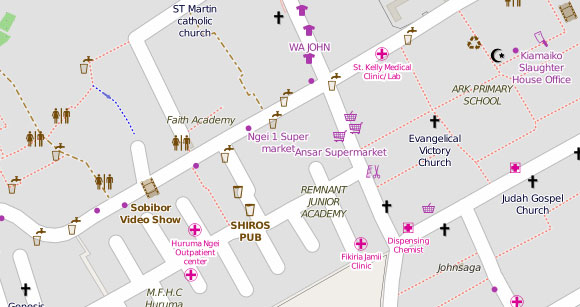
A detail of the Mathare Slum as seen in the MapKibera initiative. Image © MapKibera
Avinash Rajagopal and I, as part of Superscript, contributed an analysis of contemporary digital design in Africa to the accompanying catalogue of Making Africa. The natural culmination of our role as Consultants for New Media and Technology, and members of the Advisory Board, the essay was a pleasure to write and research, and wouldn’t have been possible without the invaluable assistance of Dalia Ohtman, a Research Fellow at the Berkman Center for Internet & Society at Harvard University and a Visiting Scholar at the MIT Center for Civic Media. An excerpt of the essay can be read after the jump.
Profile Picture: Digital Design from Africa
Avinash Rajagopal, Vera Sacchetti
As of June 2014, there were close to 300 million Internet users in Africa. Large as that number may seem, it means that only an estimated 26.5% of the people on the vast continent live in the digital age. It seems like one can add a digital divide to the long, too-frequently touted list of inequities that persist in this part of the world.
As with all statistics, of course, what these numbers conceal is far more interesting than what they reveal. One thing they hide are the deep roots of the Internet divide. Physically, these stretch under the depths of the Atlantic and Indian oceans, to the fibre optic cables that carry data to and from Africa. Historically—as with so many things on the continent—these roots extend to the years of European colonial rule.
Speaking at the Afrofuture exhibit at the Milan Furniture Fair in 2013, designer James Bridle considered the digital connections between metropolises in Europe and Africa. “The routes of the cables still follow the old imperial shipping routes.,†he pointed out in an interview with Domus magazine. “It’s still the old imperial powers that do that engineering, that bring that information to Africa, and in some sense control it. I’m really interested in African companies…that are financing and building their own cables.â€Â Hamilton Research, based out of Bath, UK, do a splendid job of making these hidden infrastructures of information—and control—visible with their finely detailed Africa Bandwidth Maps, which show the coverage of radio frequencies, microwave radio links, and underground and underwater cables all over the continent. Produced yearly, the maps show a slow but hopeful shift towards greater digital penetration.
Another thing that dry quantitative assessments conceal is the qualitative state of the Internet in Africa. In the North, Egyptians, Libyans and Tunisians leveraged social media to bring about the Arab Spring. Four years later, the weather might not be so pleasant for the activists, but they have certainly transformed the digital landscape forever, for themselves and the world. In South Africa, the most prosperous nation on the continent, the layering of the Internet age on the post-apartheid years has produced astonishing cultural expressions. Nairobi in the East and Lagos in the West buzz with tech entrepreneurship, complete with start-up offices, international funding, and inevitable talk of local Silicon Valleys.
Designers for the digital age are producing enormous creative output on the continent, and the rest of the world would do well to pay attention. Only, that’s not something the rest of the world has been very good at, historically speaking.
[…]
In 1995, sociologist and psychologist Sherry Turkle wrote in her seminal book about online identities: “A rapidly expanding system of networks, collectively known as the Internet, links millions of people in new spaces that are changing the way we think, the nature of our sexuality, the form of our communities, our very identities…we are dwellers on the threshold between the real and virtual, unsure of our footing, inventing ourselves as we go along.â€Â This sense of constructing ourselves, and having our selves constructed for us, feels familiar and mundane to us today as users of Facebook and Instagram, even as the complex set of relationships that Turkle describes have grown ever more tangled.
Could what applies to individuals also be applied, mutatis mutandis, to whole countries? Or even continents? Certainly a continent like Africa faces the same issue that many of us do in our daily Internet lives: it has its digital identity constructed daily through both external and internal agents. In the case of the latter, there are constant efforts at course correction, to mould the portrayal of their homeland in the eyes of the world. At a macroscopic level, the continent of Africa as a digital entity is already part of a network with powerful members among both organizations and individuals—influential researchers and entrepreneurs from outside are invested in the continent, as are giants like Google (even a quick perusal of the informative Google Africa Blog should prove sufficient evidence of this) and educational and cultural institutions like the British Council (which is building a Maker Library Network in South Africa). As any number of bright-eyed designers and developers will attest, Africa plays out many of its dreams and fantasies online. Once we make this conceptual leap, then it is easy to see the continent poised at the threshold that Turkle so evocatively describes.
Then it also makes sense to ask—as Turkle has done for human beings—not just what digital design is doing for Africa, but what it is doing to Africa.
Viral Youtube videos and a host of online zines are proof enough that, unlike what usually transpires in the continent’s other unequal interactions with the Global North, the Internet era in Africa need not be circumscribed by the customary neoliberal baggage of aid, development, progress, and social change. As African nations build their own Internet infrastructure, and designers create models of success that are already being exported to the rest of the world, it feels as though in this arena, Africa’s international relationships might well be interdependent, not codependent. It may not be too much to hope that not only will Africa stridently inhabit the digital age, but that one day the digital age will be African.